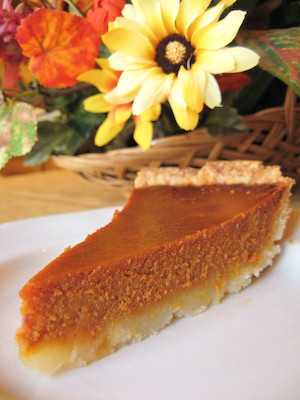from Baking: From My Home to Yours, by Dorie Greenspan
1 9-inch single crust made with Good for Almost Everything Pie Dough, partially baked and cooled (recipe below)
1 cup sugar
3/4 cup heavy cream
2 tablespoons dark rum, cognac, or apple cider
2 tablespoons unsalted butter, cut into 4 pieces
1 cup canned pumpkin puree
1 1/4 teaspoons ground cinnamon
3/4 teaspoon ground ginger
pinch of freshly grated nutmeg
tiny pinch of ground allspice
pinch of salt
1 1/2 teaspoons pure vanilla extract
2 large eggs
Lightly sweetened whipped cream, for serving

Getting Ready:
Center a rack in the oven and preheat the oven to 350 degrees F. Place the pie plate on a baking sheet lined with parchment or a silicone mat.
Sprinkle 1/2 cup of the sugar evenly over the bottom of a large nonstick skillet. Place the skillet over medium-high heat and staying close by, cook until the sugar melts and starts to color. Once you see a little color, gently swirl the skillet so that the sugar colors evenly. Cook the sugar, without stirring, until it turns deep amber--almost mahogany. The sugar will bubble up and foam and soon it will start to smoke. It is very dramatic, and it might make you think you've gone too far, but you want a dark (though not burned black) color; the darker the sugar, the fuller the flavor. When the bubble shave gone from foamy to big and fat, you will probably have reached the right color. To check the color, drop a bit of the caramelized sugar on a white plate.
Lower the heat to medium, stand back and pour the cream into the skillet. The sugar will bubble and hiss and, if the cream was cold, it may even clump. Just continue to cook, stirring, and it will even out. Add the rum (or cider) and butter and cook just until the caramel is smooth. Pour the caramel into a heatproof pitcher or bowl and cool it for about 15 minutes.
Working with a whisk in a large bowl, beat the pumpkin to break it up and smooth it. Add the remaining 1/2 cup sugar and beat to blend. Whisk in the spices, salt, vanilla and eggs, beating until the mixture is smooth. Whisk in the caramel. Rap the bowl against the counter a few times to de-bubble the filling, then pour the filing into the crust.
Bake for 45 to 50 minutes, or until the filling is puffed and set--tap the pan gently and the filling won't jiggle. A thin knife inserted into the center of the pie will come out clean--it also leave a gash in the filling, but you'll be covering it with whipped cream.
Transfer the pie to a rack and cool to room temperature, or cool and refrigerate. When you are ready to serve, spread the lightly whipped cream over the top of the pie. If you'd like a dressier look, whip the cream until it is firm, put it into a piping bag fitted with a start tip and pipe rosettes over the surface of the pie. Alternatively, you can pipe the cream in a lattice pattern.
Playing Around:
Streuseled Caramel Pumpkin Pie
Pecan Streusel
To add a little crunch to this dessert, bake the pie for 10 minutes, then scatter chunks of pecan streusel over the top and finish baking.
2 tablespoons all-purpose flour
2 tablespoons brown sugar
2 tablespoons chopped pecans
2 tablespoons cold butter
Mix until crumbly. Refrigerate until ready to use.
Good for Almost Everything Pie Dough
For a 9 inch Single Crust
1-1/2 cups all purpose flour
2 tbsp sugar
3/4 tsp salt
1 ½ sticks (10 tbsp) very cold unsalted butter, cut into tbsp size pieces
2-1/2 tbsp very cold vegetable shortening, cut into 4 pieces
About 1/4 cup ice water
Put the flour, sugar, and salt in a food processor fitted with a metal blade, pulse just to combine the ingredients. Drop in the butter and shortening and pulse only until the butter and shortening are cut into the flour. Don’t overdo the mixing- what you’re aiming for is to have some pieces the size of fat green peas and others the size of barley. Pulsing the machine on and off, gradually add about 3 tablespoons of the water- add a little water and pulse once, add some more water, pulse again and keep going that way. Then use a few long pulses to get the water into the flour. If, after a dozen or so pulses, the dough doesn’t look evenly moistened or form soft curds, pulse in as much of the remaining water as necessary, or even a few drops more, to get a dough that will stick together when pinched. Big pieces of butter are fine. Scrape the dough out of the bowl and onto a work surface.
Divide the dough in half. Gather each half into a ball, flatten each ball into a disk and wrap each half in plastic. Refrigerate the dough for at least 1 hour before rolling (if your ingredients were very cold and you worked quickly, though, you might be able to roll the dough immediately: the dough should be as cold as if it had just come out of the fridge).
To Roll Out the Dough:
Have a buttered 9 inch pie plate at hand.
You can roll the dough out onto a floured surface or between sheets of wax paper or plastic wrap or in a rolling slipcover. If you’re working on a counter, turn the dough over frequently and keep the counter floured. If you are rolling between paper, plastic or in a slipcover, make sure to turn the dough over often and to life the paper, plastic, or cover frequently so that it doesn’t roll into the dough and form creases.
If you’ve got time, slide the rolled out dough into the fridge for about 20 minutes to rest and firm up.
No comments:
Post a Comment